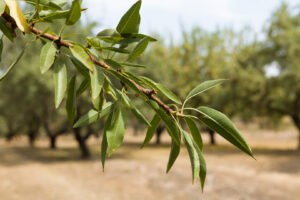March/April 2024
‘Spoon-feeding’ nitrogen to almond trees helps maximize investment, minimize inefficiencies
Nutrient application, such as nitrogen application, is undoubtedly one of the most important “make or break” economic and environmental decisions almond growers make. Not only can nitrogen affect yields and productivity, but growers can see a huge difference in their profit margins if applied efficiently.
“When we think about managing nutrients such as nitrogen, our goal is the balance between supply, all of the inputs of nitrogen into the system, and the demand of the tree with the goal of maximizing your efficiency,” said Patrick Brown, professor at UC Davis during a 2023 Almond Conference session. Because nitrogen application can differ from one crop to the next, Brown encouraged growers to fully understand the conditions of their individual orchard before applying fertilizer. This includes when it is needed, how much should be applied, the placement and source.

Minimizing losses
The goal when using these considerations is to minimize losses, with environmental concerns being top of mind.
“Any loss is a lack of efficiency, but any loss is also a source of greenhouse gasses for pollution or a source of nitrates for pollution into the groundwater,” Brown said.
Research has shown that nitrates move through the soil very rapidly, and as growers increase application, uptake of nutrients from the soil is not uniform. For example, if fertigation is infrequent and application exceeds a certain rate, saturation can occur causing waste or leaching.
“A large proportion of that nitrogen will sit in the root zone waiting for the plant to catch up,” he said. “This is an important principle because it underlies where and how inefficiencies occur.”
Growers can avoid these scenarios if they follow the 4 Rs of nutrient management: right rate, at the right time and in the right place, using the right source of nutrients. An in-depth explanation of the 4 Rs can be found on the Almond Board of California’s (ABC) website.
Right time
First, it’s important to understand the ideal time to apply nitrogen to an almond orchard. Studies show there is no nitrogen uptake from the soil at 7-% leaf out because the tree is still utilizing reserves established in the previous year. Until those reserves are consumed, new uptake doesn’t occur, and that’s where loss transpires, Brown explained.
“Those early excesses are particularly prone to losses from rainfall, irrigation, and other events, so you have an increasing number of periods where there’s excess availability of nutrients and hence, the potential for loss,” he said.
Instead, optimal fertilization will occur with multiple applications in a season, timed accordingly with the demand of the tree.
Active root zone placement
Another key aspect of nitrogen application is placement. This is where growers must be educated in understanding the relationship between irrigation and nitrogen movement. Nitrogen that sits on the surface of the soil and remains in the top five inches will be lost if water moves through the profile.
In order to be utilized properly, nitrogen must be kept within the active root zone, which through research, has proven to typically be within the top 18 inches of soil. This is especially true for the young roots that are highly active in feeding, Brown explained.
So, how can growers ensure fertilizer applications remain within the active root zone? Brown said this depends on the integration of how and when an orchard is fertilized and how and when it is irrigated.
“Your goal optimum irrigation is a fertilizer application towards the end of the irrigation event so that you don’t push it through the profile,” Brown said. “This is another example of where having small, spoon-feeding applications minimizes the potential of pushing the nitrogen through the profile.”
Less is more
This “spoon-feeding” method is known as continuous fertigation (fertilizing with every irrigation) as opposed to episodic fertigation (fertilizing once every month or two).
If there is too much excess caused by episodic fertigation, that is where inefficiencies occur causing leaching or gaseous nitrogen losses, which can come with a number of implications for the air resources board and grower.
Another factor that needs to be considered is how irrigation distribution uniformity determines nitrogen distribution uniformity.
“If you have a very uniform irrigation system, you inject 250 pounds of nitrogen in a year, and you will be able to deliver that 250 pounds uniformly across the orchard,” Brown said. “If you have a distribution uniformity that’s poor, not only are you not distributing water uniformly, but every time you do an injection of a fertilizer, you’re also not distributing the fertilizer uniformly.”
Grower resources
Because of the increasing complexities involved in the relationship between irrigation and fertilization, the ABC built the California Almond Stewardship Platform (CASP).
For more information on CASP, visit almondstewardship.org. The platform offers growers tools as it relates to their operation and can run iterations based on customizable inputs. Using the solutions computed by CASP, growers can determine the best path for an individual orchard.
It’s well recognized that continuous fertigation requires dedicated equipment and constant vigilance from the grower. However, the investment will be worthwhile when efficiency savings and productivity boosts are taken into consideration, Brown assured.
“It’s very clear that for profitability, efficiency, lack of nitrogen loss, and environmental considerations, that continuous fertilization strategies are the secret to success,” he concluded.







